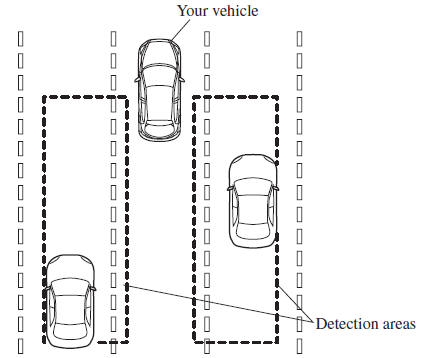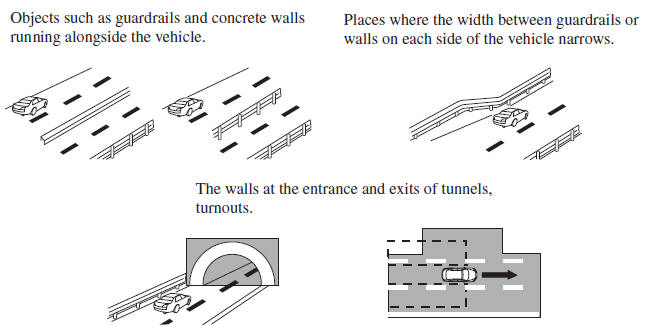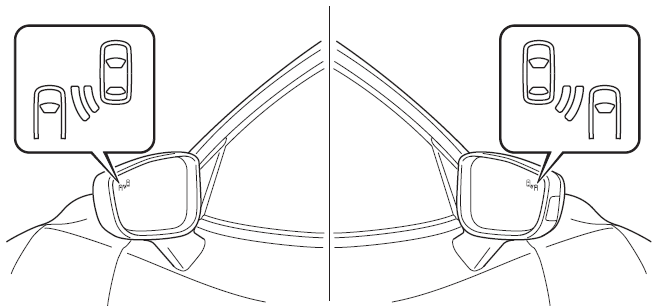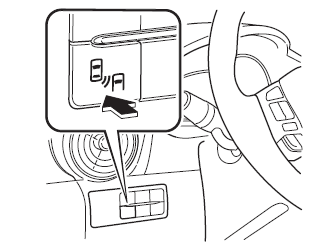
Mazda 2: Blind Spot Monitoring (BSM) System
Mazda2 Owners Manual
The Blind Spot Monitoring (BSM) system is designed to assist the driver in checking the area to the rear of the vehicle on both sides during lane changes by alerting the driver to the presence of vehicles approaching from the rear in an adjacent lane.
The Blind Spot Monitoring (BSM) system detects vehicles approaching from the rear while travelling in the forward direction at a speed of 30 km/h (19 mph) or faster and turns on the Blind Spot Monitoring (BSM) warning lights equipped on the door mirrors depending on the conditions. If the direction indicator lever is operated to signal a lane change in the direction in which the Blind Spot Monitoring (BSM) warning light is illuminated, the system warns the driver of a vehicle in the detection area by fl ashing the Blind Spot Monitoring (BSM) warning light and activating a beep sound.
The detection area on this system covers the driving lanes on both sides of the vehicle and from the rear part of the front doors to about 50 m (164 ft) behind the vehicle.

WARNING
Always check the surrounding area visually before making an actual lane change: The system is only designed to assist you in checking for vehicles at your rear when making a lane change. Due to certain limitations with the operation of this system, the Blind Spot Monitoring (BSM) warning light may not fl ash or it might be delayed even though a vehicle is in an adjacent driving lane. Always make it your responsibility as a driver to check the rear.
NOTE
The Blind Spot Monitoring (BSM) system will operate when all of the following conditions are met:
- The ignition is switched ON.
- The Blind Spot Monitoring (BSM) switch is pressed and the Blind Spot Monitoring (BSM) OFF indicator light in the instrument cluster is turned off.
- The vehicle speed is about 30 km/h (19 mph) or faster.
The Blind Spot Monitoring (BSM) system will not operate under the following circumstances.
- The vehicle speed falls below about 25 km/h (15 mph) even though the Blind Spot Monitoring (BSM) OFF indicator light is turned off.
- The shift lever (manual transaxle)/selector lever (automatic transaxle) is shifted to reverse (R) and the vehicle is reversing.
In the following cases, the Blind Spot Monitoring (BSM) OFF indicator light is turns on and operation of the system is stopped. If the Blind Spot Monitoring (BSM) OFF indicator light remains illuminated, have the vehicle inspected at an Authorised Mazda Dealer as soon as possible.
- Some problem with the system including the Blind Spot Monitoring (BSM) warning lights is detected.
- A large deviation in the installation position of a radar sensor (rear) on the vehicle has occurred.
- There is a large accumulation of snow or ice on the rear bumper near a radar sensor (rear). Remove any snow, ice or mud on the rear bumper.
- Driving on snow-covered roads for long periods
- The temperature near the radar sensors (rear) becomes extremely hot due to driving for long periods on slopes during the summer.
- The battery voltage has decreased.
Under the following conditions, the radar sensors (rear) cannot detect target objects or it may be diffi cult to detect them.
- A vehicle is in the detection area at the rear in an adjacent driving lane but it does not approach. The Blind Spot Monitoring (BSM) system determines the condition based on radar detection data
- A vehicle is travelling alongside your vehicle at nearly the same speed for an extended period of time.
- Vehicles approaching in the opposite direction.
- A vehicle in an adjacent driving lane is attempting to pass your vehicle.
- A vehicle is in an adjacent lane on a road with extremely wide driving lanes. The detection area of the radar sensors (rear) is set at the road width of expressways.
In the following cases, the activation of the Blind Spot Monitoring (BSM) warning lights and the warning beep may not occur or they may be delayed.
- A vehicle makes a lane change from a driving lane two lanes over to an adjacent lane.
- Driving on steep slopes.
- Crossing the summit of a hill or mountain pass.
- The turning radius is small (making a sharp curve, turning at intersections).
- When there is a difference in the height between your driving lane and the adjacent lane.
- Directly after pressing the Blind Spot Monitoring (BSM) switch and the system becomes operable.
If the road width is extremely narrow, vehicles two lanes over may be detected.
The detection area of the radar sensors (rear) is set according to the road width of expressways.
The Blind Spot Monitoring (BSM) warning lights may turns on in reaction to stationary objects on the road or the roadside such as guardrails, tunnels, sidewalls, and parked vehicles.

A Blind Spot Monitoring (BSM) warning light may fl ash or the warning beep may be activated several times when making a turn at a city intersection.
Turn off the Blind Spot Monitoring (BSM) system while pulling a trailer or while an accessory such as a bicycle carrier is installed to the rear of the vehicle. Otherwise, the radar’s radio waves will be blocked causing the system to not operate normally.
In the following cases, it may be diffi cult to view the illumination/fl ashing of the Blind Spot Monitoring (BSM) warning lights equipped on the door mirrors.
- Snow or ice is adhering to the door mirrors.
- The front door glass is fogged or covered in snow, frost or dirt.
The system switches to the Rear Cross Traffi c Alert function when the shift lever (manual transaxle) or the selector lever (automatic transaxle) is shifted to the reverse (R) position.
Refer to Rear Cross Traffi c Alert (RCTA) on page 4-115 .
Blind Spot Monitoring (BSM) Warning Lights/Blind Spot Monitoring (BSM) Warning Beep
The Blind Spot Monitoring (BSM) or Rear Cross Traffi c Alert (RCTA) system notifi es the driver of the presence of vehicles in adjacent lanes to the rear of your vehicle using the Blind Spot Monitoring (BSM) warning lights and the warning beep while the systems are operational.
Blind Spot Monitoring (BSM) warning lights
The Blind Spot Monitoring (BSM) warning lights are equipped on the left and right door mirrors. The warning lights turn on when a vehicle approaching from the rear in an adjacent lane is detected.

When the ignition is switched ON, the malfunction warning light turns on momentarily and then turns off after a few seconds.
Forward driving (Blind Spot Monitoring (BSM) system operation)
The Blind Spot Monitoring (BSM) system detects vehicles approaching from the rear and turns on the Blind Spot Monitoring (BSM) warning lights equipped on the door mirrors according to the conditions. Additionally, while a Blind Spot Monitoring (BSM) warning light is illuminated, if the direction indicator lever is operated to signal a turn in the direction in which the Blind Spot Monitoring (BSM) warning light is illuminated, the Blind Spot Monitoring (BSM) warning light fl ashes
Reverse driving (Rear Cross Traffi c Alert (RCTA) system operation)
The Rear Cross Traffi c Alert (RCTA) system detects vehicles approaching from the left and right of your vehicle and fl ashes the Blind Spot Monitoring (BSM) warning lights.
Function for cancelling illumination dimmer
When the headlight switch is in the
 or
or
 position, the brightness of the
position, the brightness of the
Blind Spot
Monitoring (BSM) warning lights is dimmed.
If the Blind Spot Monitoring (BSM) warning lights are diffi cult to see due to glare from surrounding brightness when travelling on snow-covered roads or under foggy conditions, press the dimmer cancelation button to cancel the dimmer and increase the brightness of Blind Spot Monitoring (BSM) warning lights when they turn on.
Refer to Instrument panel Illumination on page 4-31 .
Blind Spot Monitoring (BSM) warning beep
The Blind Spot Monitoring (BSM) warning beep is activated simultaneously with the fl ashing of a Blind Spot Monitoring (BSM) warning light.
Blind Spot Monitoring (BSM) OFF Indicator Light
 When the ignition is switched
When the ignition is switched
ON, the
malfunction warning light turns on
momentarily and then turns off after a
few seconds.
The Blind Spot Monitoring (BSM) OFF indicator light illuminates when the Blind Spot Monitoring (BSM) switch is pressed to turn off the Blind Spot Monitoring (BSM) and Rear Cross Traffi c Alert (RCTA) systems.
A malfunction in the system may be indicated under the following conditions. Have your vehicle inspected at an Authorised Mazda Dealer.
- The light does not turn on when the ignition is switched ON.
- It remains illuminated even though the Blind Spot Monitoring (BSM) switch has been switched off.
- It turns on while driving the vehicle.
Blind Spot Monitoring (BSM) Switch

When the Blind Spot Monitoring (BSM) switch is pressed, the Blind Spot Monitoring (BSM) and Rear Cross Traffi c Alert (RCTA) systems are turned off and the Blind Spot Monitoring (BSM) OFF indicator light in the instrument cluster turns on.
If the switch is pressed again, the Blind Spot Monitoring (BSM) and Rear Cross Traffi c Alert (RCTA) systems become operable and the Blind Spot Monitoring (BSM) OFF indicator light turns off.
NOTE
- When the ignition is switched off,
the condition before the system
was turned off is maintained.
For example, if the ignition is switched OFF while the Blind Spot Monitoring (BSM) and Rear Cross Traffi c Alert (RCTA) systems are operational, the Blind Spot Monitoring (BSM) and Rear Cross Traffi c Alert (RCTA) systems remain operational the next time the ignition is switched ON.
- The Blind Spot Monitoring (BSM)
and Rear Cross Traffi c Alert (RCTA)
systems are turned off when the
battery is disconnected such as
when the battery terminals or fuses
have been removed and re-installed.
To turn the Blind Spot Monitoring (BSM) and Rear Cross Traffi c Alert (RCTA) systems back on, press the Blind Spot Monitoring (BSM) switch.
Other info:
Ford Fiesta. Cruise Control, Driving Aids
Cruise Control
Principle of Operation
WARNING
The system does not relieve you of
your responsibility to drive with due
care and attention.
Cruise control allows you to control your
speed using the swi ...
Skoda Fabia. Air conditioning system (manual air conditioning system)
The cooling system operates only if the following conditions are met.
The cooling system is switched on » page 89.
The engine is running.
The outside temperature is above approximately +2 °C ...
Renault Clio. Emergency brake assist
This system supplements the ABS
and helps reduce vehicle stopping distances.
Operating principle
The system is for detecting an emergency
braking situation. In this case,
the braking assistance i ...
Manuals For Car Models
-
 Chevrolet Sonic
Chevrolet Sonic -
 Citroen C3
Citroen C3 -
 Fiat Punto
Fiat Punto -
 Honda Fit
Honda Fit -
 Mazda 2
Mazda 2 -
 Nissan Micra
Nissan Micra -
 Peugeot 208
Peugeot 208 -
 Renault Clio
Renault Clio -
 Seat Ibiza
Seat Ibiza -
 Skoda Fabia
Skoda Fabia - Honda Pilot
- Volkswagen ID4
- Toyota Prius


